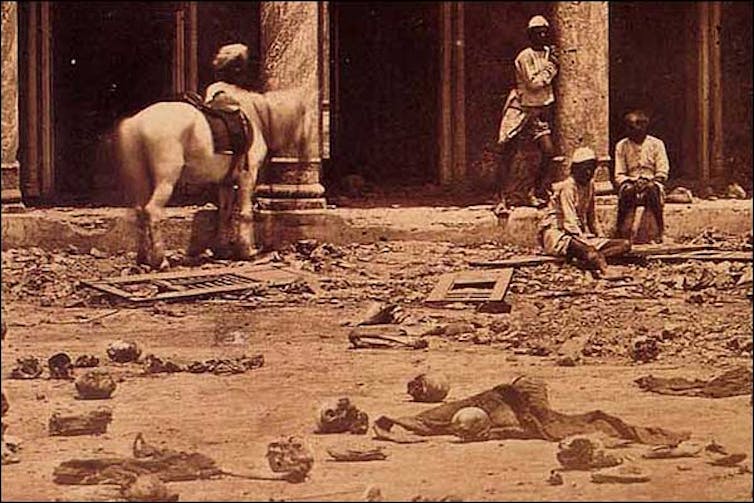What War Did the Bullets With Cartriges Covered in Beef and Park Fat
On first reading well-nigh the protests because the new plastic British v-pound notation contains fauna fat – and the mass petition to have it withdrawn – I immediately thought of the protests in 1857 that led up to the Indian Wildcat rebellion. "You lot'd accept thought we'd have learned the lesson since then," I said to myself.
Of course, the introduction – for use by the British regular army and its Indian troops – of a new cartridge for the 1853 Enfield rifle which had allegedly been greased in grunter and cow fatty, was non the cardinal trigger for the British Empire's biggest revolt. Its power lay more in its force equally a rumour than it leading to actual cases of Hindus or Muslims being direct polluted via contact with creature products.
Just this is in some means beside the indicate – every bit is the case with the petition started by Doug Maw, a hotel worker from Cumbria. The 120,000-odd petitioners – including vegetarian and vegan cafés across the U.k. and a range of religious groups – are probably aware of the fact that plastic bags, crayons, cosmetics, soaps and detergents, latex, toothpaste, and candles contain animal fats, as well. Simply the tangibility and exchangeability of a banknote – its symbolic and textile power – brings a greater social significance to the contaminated fiver.
Cartridges and chapatis
Like the greased cartridge affair of 1857, and so, these symbolic campaigns suggest that the state's human relationship with consumer groups is delicate and the nature of political communication is ebullient. Key aspects of the £5 protestation are its forms of rapid manual. In 2016, social media allowed Maw'due south greased fiver petition to quickly assemble momentum. Similarly, the mysterious appearance of thousands of chapatis being passed from paw to hand among sepoy soldiers across northern Republic of india in February and March 1857, led British officials to surmise that the spread of this odd secret message, which outpaced the mail service, might be the harbinger of something serious.

The chapati wave had no proven link to the rebellion of May 1857 – despite official beliefs to the reverse. Nevertheless, regime disconnection and security paranoia – too every bit the enormous possibilities of mass communication via objects – characterise these moments of symbolic token distribution at both times.
Then information technology is worth pausing to consider the historical signs running through these bendy notes, both religious and secular. In calling people to join the fiver ban, the National Council for Hindu Temples in the Britain fabricated explicit reference to 1857, and the utilise of sus scrofa and cow grease in its statement of one December 2016.
The ensuing revolution has been called the Offset Indian Revolution … and helped to focus such a sense of national identity that many remark that it created the moving ridge of anti British rhetoric which coalesced in the expulsion of the colonialists and ultimately the demise of the British Empire. Could an adharmic £5.00 be an equally expensive fault? Time will tell.
Claiming that the "devout Brahmin" Mangal Pandey'due south discovery of the contamination sparked the ultimate "demise of the British Empire" is hyperbole, but Hindu organisations in particular describe on a deeper history of anti-colonial protest rooted in creature product taboos. From the 1880s through to the 1930s, for instance, protests against the slaughter of cows and the use of cow products in manufactured goods served as a mobilising (albeit religiously divisive) symbol across north India.
E'er since its ballot in 2014, the BJP and its associated organisations take too maintained a multi-faceted campaign to end cow slaughter in Republic of india, specifically targeting Muslim and low-caste traders in hides and meat.
Moral dilemma
In other ways, though, these reactions are predominantly secular and illustrate how minority groups perceive or articulate their political rights. Hindu, Sikh and Jain temples take pointed to the importance of "charitable donations" to their sustenance and the moral dilemma posed by the £5 note. Likewise, cafes in the UK banning the note have pointed out that they make a living past non having animal products anywhere near their establishments.
The twitter storm around the dirty fiver fabricated references to the "rights" of vegans, vegetarians and religious communities, whose ire was raised against Professor David Solomon, inventor of the note for Innovia, for describing protesters as "stupid".
But nosotros might also consider hither the significant moral buy of vegetarianism in relative terms. At that place have been no protests yet confronting the inclusion of Winston Churchill's epitome on the annotation – a diehard opponent of Indian independence and a homo widely believed in India to have been responsible for the deaths of more than 3m during the Bengal Famine of 1943.
It may be that the United kingdom Treasury volition bite the bullet and consider new forms of industry before it releases the planned polymer £10 note featuring the image of Jane Austen in 2017. And in that year of the 70th anniversary of India's independence, we might also consider anew – like Austen'southward Colonel Brandon with his E India fortune, or the Austens' friendship with Warren Hastings – the many difficult and ambivalent relationships betwixt United kingdom of great britain and northern ireland and India.
Source: https://theconversation.com/five-pound-history-lesson-animal-fat-and-the-british-empires-biggest-revolt-70004
Post a Comment for "What War Did the Bullets With Cartriges Covered in Beef and Park Fat"